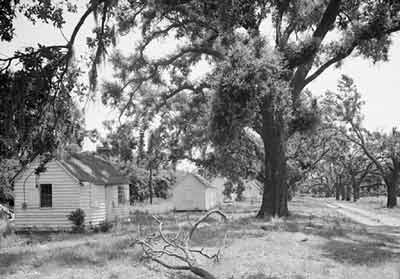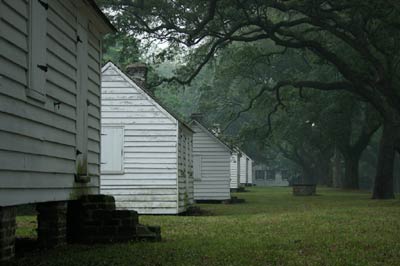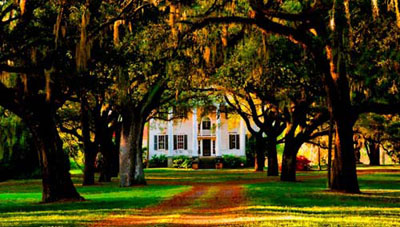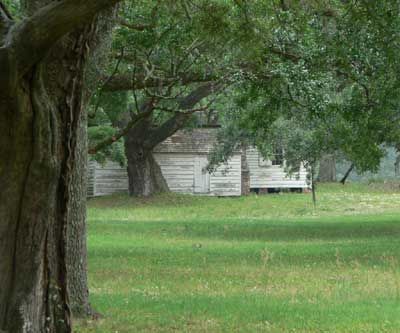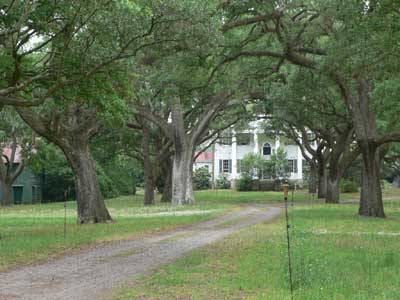McLeod Plantation – James Island – Charleston County
Basic Information
- Location – Wappoo Creek, James Island, St Andrews Parish, Charleston County
Located on left side of SC 171 (Folly Road), just after it crosses Wappoo Creek onto James Island
- Origin of name – Named for William Wallace McLeod, who acquired the plantation in 1851
- Other names – Nicknamed "Pick-Pocket Place" in first half of nineteenth century because all endeavors to grow cotton there had been unsuccessful
- Current status – In 1990, the Historic Charleston Foundation inherited one-third of McLeod Plantation from William McLeod, who had no heirs. In his will, "Mr. Willie," as he was affectionately known, stipulated that the home should remain a "single family residence" and that the foundation should "preserve the Oak Avenues, and ... provide that as much of the property as possible be restricted to single family residence or residences having the lowest possible density." (Read Mr. Willie's will in PDF.)
The foundation instead bought out the other shareholders and sold the property to the American College of Building Arts. The college, which was not financially stable despite receiving a large loan from the City of Charleston, eventually sold the plantation back to the Historic Charleston Foundation (a stipulation of the original sale).
The Historic Charleston Foundation then tried to sell McLeod Plantation to the College of Charleston, which planned to use the house for entertaining and the land for intramural sports. Strong opposition from Civil War historians, African-American historians, and the people of James Island led the college to forego the purchase.
To the relief of the surrounding community, the plantation was purchased by Charleston County Parks and Recreation in early 2011 for $3.3 million. The county restored the site and open it to public tours in April 2015.
Timeline
- 1671 – Earliest known date of existence
Morgan Morris of Virginia was the first person to own the 617-acre tract that became McLeod Plantation. Morris was an absentee owner and had no residence on the property.
- 1685 – First Rivers family to come to America built a home near where Wappoo Creek meets Ashley River, on land where Country Club of Charleston is now located
- 1696 – Morris Morgan listed as owner of portion of plantation near Wappoo Creek bridge
- 1703 – Captain David Davis received plantation as royal grant.
- 1706 – Davis sold plantation to William Wilkins.
- 1741 – Wilkins sold the plantation to Samuel Perronneau, who was likely the first owner to cultivate it.
- 1753 – Perronneau's will commands his executors to buy "such a number of slaves as to enable them to settle, plant, and occupy my plantation and lands on James Island." Plantation still consisted of 617 acres.
- 1770 – 250 acres sold or given to Elizabeth and Edward Lightwood II, Perronneau's daughter and son-in-law. Lightwood was a ship owner and slave trader, partner in the brokerage firm Lightwood and Everleigh. Lightwood owned at least 53 slaves in St Andrews Parish but was unsuccessful at growing cotton due to depleted and poorly-drained soil. He erected the first house and outbuildings on the property; it is unknown what became of the house.
- 1785 – "Map of the Plan of the siege of Charleston indicates that a main house existed in the area of the present-day McLeod, and that the house was approached from the north by a tree-lined path from Wappoo Creek" (8).
- ? – Plantation purchased by Lightwood's son-in-law, William McKenzie Parker II (also a slave trader). Parker added an additional 779 acres of marsh to the property, increasing the total acreage to 914.5. (Lightwood's daughter was named Sarah.)
- 1851 – Parker sold plantation to Edisto Island cotton planter William Wallace McLeod, who addressed the soil problems. Plantation's footprint extended from confluence of Wappoo Creek and Ashley River westward down Wappoo Creek to about Fleming Road ... then south to James Island Creek ... then east to Charleston Harbor ... then north back to confluence of Ashley River and Wappoo Creek.
- 1856 – McLeod built house that stands today.
- 1861-1865 – Confederate divisional field hospital
- 1865 – Camp for 54th and 55th Massachusetts Volunteers
- 1865 – Mass burial of Union soldiers on what is now golf course at Country Club of Charleston
- 1865 – Temporary location of Freedmen's Bureau
- 1990 – William Ellis McLeod, known affectionately to his neighbors as "Mr. Willie," died without an heir. He left one-third of his plantation to the Historic Charleston Foundation. His will stipulated that the home should remain a "single family residence" and that the foundation should "preserve the Oak Avenues, and ... provide that as much of the property as possible be restricted to single family residence or residences having the lowest possible density." (Read Mr. Willie's will in PDF.)
- 1993 – The remaining two-thirds of plantation were bought by Historic Charleston Foundation.
- 1996 – A slave cemetery with nearly 100 graves was discovered.
- 2004 – The Historic Charleston Foundation sold the plantation to the American College of Building Arts for a campus. Debate surged surrounding planned property uses, which included converting the cabins to classrooms, converting the house to a suite for guests and board members, and adding parking lots.
- 2008 – Financially unstable, the American College of Building Arts evoked a stipulation of their original purchase agreement and sold McLeod back to the Historic Charleston Foundation.
- 2009-2010 – The Historic Charleston Foundation then tried to sell the property to the College of Charleston. The college planned to use the house for entertaining and the land for intramural sports. Strong public opposition to this plan halted the deal.
- 2011 – With widespread community support, the plantation was purchased by Charleston County Parks and Recreation Commission for $3.3 million. The county plans to restore the site and open it for public use.
- 2015 – The Charleston County Parks and Recreation Commission completed the building stabilization project and construction of a welcome center, pavilion, and creek viewing dock. In April, the plantation was opened for public tours.
Land
- Number of acres – 617 acres in 1671, 1696; 914.5 in 1851; 54 in 2004; 39 in 2005; 37 in 2015
- Primary crop – beef; some indigo, long-staple Sea Island cotton, and rice
"At its peak, William McLeod ran one of South Carolina's largest Sea Island cotton plantations – more than 900 acres yielding 100 bales a year" (8).
Owners
- Alphabetical list – American College of Building Arts; Charleston County Parks and Recreation Commission; Captain David Davis; Historic Charleston Foundation; Elizabeth and Edward Lightwood II; William Ellis McLeod; William Wallace McLeod; Morgan Morris; William McKenzie Parker II; Samuel Perronneau; William Wilkins
- Chronological list – Morgan Morris (1671-?); Captain David Davis (1703-1706); William Wilkins (1706-1741); Samuel Perronneau (1741-?); Elizabeth and Edward Lightwood II (1770-?); William McKenzie Parker II (?-1851); William Wallace McLeod (1851-?); William Ellis McLeod (?-1990); Historic Charleston Foundation (1990-2004); American College of Building Arts (2004-2008); Historic Charleston Foundation (2008-2011); Charleston County Parks and Recreation Commission (2011-present, 2015)
Slaves
- According to 1790 census, Lightwood owned 53 slaves in St. Andrews Parish.
- In 1860 McLeod Plantation had 74 slaves living in 26 dwellings (some sources say 23).
- Slaves were from Gambia River region of Africa. They were expert horseman and cattle herders and were America's first cowboys!
- The process of making blue dye from indigo plants made slaves sick and many died of cancer.
- It is said that the old bell which still hangs from an oak near the main house was used to call slaves in from the field. However, this bell was not forged until 1921.
Buildings
- Current status – Plantation house and 5 slave cabins still exist and are in relatively good condition.
The slave cabins, as well as the dairy and kitchen buildings, are believed to date from the Lightwood/Parker period (early 19th century).
- Barn – Wooden structure possibly dating from late 19th century
- Dairy – Unique in that the eastern half is on piers while the western half has an enclosed root cellar
- Gin house – Two-story masonry and wood structure used to process cotton and maintained into the 1930s
- House – "The main house is a three-story, wood-frame structure. The interior has a double pile floor plan with a central stair hall and two interior chimneys. Originally the house was oriented to the south with a one-story raised porch supported by square columns. In 1925, the principal fascade was reoriented to be the rear or northern side of the house. This renovation, in the Southern Colonial Revival style, included an addition of a projecting portico with a fan light supported by four fluted Doric columns on a raised concrete porch base. A single-story kitchen was also added at that time." (Historic Charleston Foundation)
- Kitchen – A central chimney divides kitchen in half. One side may have been used for laundry.
- Slave cabins – 20' by 12' wooden structures sit on raised masonry pier foundations with exterior end chimneys.
– Juneteenth Stay at Slave Cabin Offers Several Firsts - Joseph McGill, a program officer for the National Trust for Historic Preservation, documents his overnight stay in a slave cabin at McLeod Plantation in June 2010
References & Resources
- Douglas W. Bostick, History of McLeod Plantation; James Island, South Carolina
(James Island, SC: Sea Island Historical Society, 1999)
 Order History of McLeod Plantation; James Island, South Carolina
Order History of McLeod Plantation; James Island, South Carolina - Friends of McLeod – nonprofit preservation organization
- Historic Plantation Rarely Seen by Public – November 2003 Herald Tribune article plus spirited commentary
- McLeod Plantation Cemetery – Avery Research Center manuscript collections - source no longer available online
- National Register of Historic Places
– Nomination form - PDF - submitted in 1974
– Photographs, architectural overview
- Juneteenth Stay at Slave Cabin Offers Several Firsts - Joseph McGill, a program officer for the National Trust for Historic Preservation, documents his overnight stay in a slave cabin at McLeod Plantation in June 2010
- 30-15 Plantation File, held by the South Carolina Historical Society
- Stephanie Hunt, A New School of Thought (CharlestonMag.com: January-February 2005, pp. 110-119).
- Information contributed by Charleston County Park & Recreation Commission.
- Ashley Heffernan, Renovation of McLeod Plantation Complete; Park Open (Charleston Regional Business Journal: April 22, 2105).
Contact Information
- Charleston County Parks and Recreation Commission
325 Country Club Drive
James Island, SC 29412
Telephone: 843-762-2172
Website: Click here
More about Charleston & James Island
- Learn more about historic Charleston County including the port city of Charleston and lovely nearby James Island. We have helpful guides to Charleston history and Charleston libraries and museums – plus Charleston bed & breakfasts, Charleston hotels, and Charleston jobs. We also have guides to James Island restaurants and Charleston real estate.
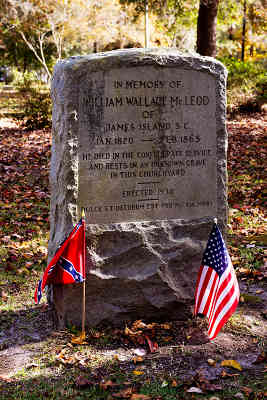
— Grave of William Wallace McLeod (in Moncks Corner) —
— © Parker Renaud, 2013 —
(Do Not Use Without Written Consent)

